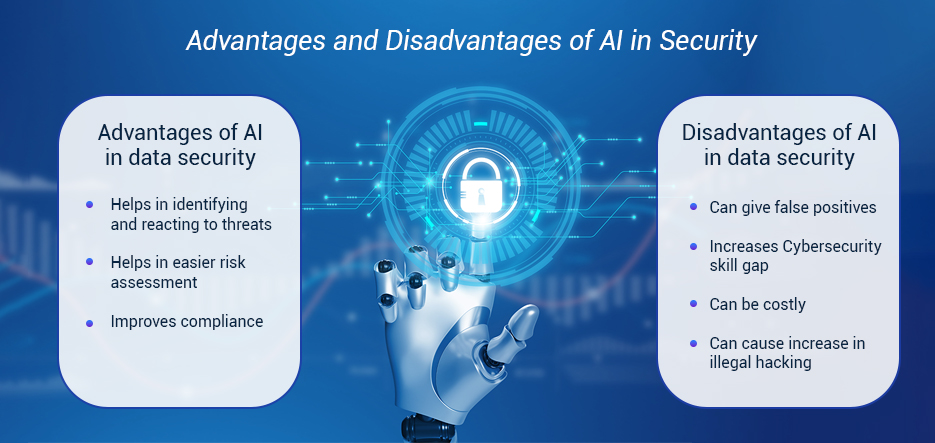Table of Contents
Cybersecurity and artificial intelligence are terms that you may have often heard thrown in together, but what exactly do the terms artificial intelligence (AI) and cybersecurity mean? Although artificial intelligence has long been utilized in cybersecurity, there will be many more uses of AI in the field in the future, both as new applications and as ways to better systems that have yet to even occur to us to employ AI in security & for digital safety. Moreover, it is being utilized widely in cybersecurity, where it may be used to power antivirus software, hunt down hackers using machine learning, or even build new ways of detecting cyber attacks that haven’t been thought of previously.
Simply put, Artificial Intelligence is a subfield of computer science concerned with teaching computers to perform activities that people perform naturally or via learning. Through machine learning, which uses artificial intelligence (AI) to identify patterns in data, it applies cybersecurity by identifying possible frauds and threats to a business. Still, a lot of people are unaware of how much longer artificial intelligence has existed.
How does Artificial Intelligence play an Important Role in Enhancing Digital Security Measures?
Artificial intelligence (AI) is fast changing our jobs and our way of living. One field where AI is becoming more and more significant is cybersecurity. Artificial intelligence in cybersecurity has shown to be a useful ally in protecting people and businesses from online attacks. With AI confidential data is secured, possible threats are recognized and reduced, and security measures are improved. Verified Market Research estimates that the market for artificial intelligence in cybersecurity was worth $17 billion in 2022 and is expected to grow to a whopping $102 billion by 2032.
Cyber threat detection and prevention: AI is excellent at seeing possible dangers and creating new algorithms to identify and stop innovative attacks because of its capacity to scan large data sets.
Protecting sensitive data: AI encrypts sensitive data to prevent malicious hackers from easily accessing it. To further strengthen data protection, it also tracks unauthorized users and keeps an eye on data access.
Worried about Insider Threats? Or Ransomware Attacks?
Get Rid of all the threats With The Help of AI
Benefits of AI for Cybersecurity
For instance, cybersecurity is one area where artificial intelligence (AI) has several useful uses and advantages. Here are a few of the main benefits and possible applications of AI in security:
Network Traffic Monitoring
AI in security effectively keeps an eye on the massive amount of data that is sent between businesses and their clientele, protecting sensitive data from fraud and unapproved access that human analysts might overlook.
Identification of Unknown Hazards
AI in security can see and react to hazards that are not yet known to humans but have the potential to do great harm before being noticed.
Vulnerability Management
With the constant flow of data, artificial intelligence (AI) skillfully detects and prevents potentially hazardous data from entering an organization’s network.
Continuous Learning
By seeing trends, classifying them, and taking proactive measures to address possible security threats, AI’s intelligent nature enables continuous network security development.
Reducing Repetitive Processes
Artificial intelligence security reduces risks by automating security basics, lowering the possibility that network exposure will occur from human error or weariness.
Enhanced Overall Security
Artificial intelligence (AI) improves overall security by effectively handling several threats simultaneously, guaranteeing timely and suitable responses to various attack types.
Enhanced Endpoint Protection
Artificial intelligence plays a critical role in device security as the number of devices used at work rises. It offers a strong defense against malware and ransomware by using signature recognition.
Data handling
Artificial intelligence security system efficiently handles the massive amounts of data that come via business networks, guaranteeing thorough scanning and analysis beyond human comprehension.
Risk Prediction
Artificial Intelligence security systems help organizations inventory and evaluate their IT assets, which enables them to anticipate possible cyberattacks, get ready for them, and focus resources on the most vulnerable areas.
Boosting Authentication
AI in security adds another degree of protection to the back end of commercial websites by safeguarding sensitive data like credit card numbers, usernames, and passwords.

What are the Essential Mechanisms of AI that Contribute to Robust Data Protection?
Data protection is one of the important aspects of AI. With so much data that AI needs to work smoothly, it has to be protected to prevent data misuse. Below are mentioned some of the best mechanisms of Artificial intelligence security that can contribute to robust data protection.
Addresses Privacy Concerns
Integrating privacy concerns from the beginning into the design and development of new technologies is known as “privacy by design.” When it comes to AI in security, privacy by design refers to the incorporation of data security measures into Artificial intelligence security systems from the very beginning.
Data Minimization
Data minimization refers to the idea that AI solution providers should only gather, handle, and archive the bare minimum of data required to complete the task at hand. This helps guarantee adherence to data protection regulations and lessens the possible harm from a data breach.
Strong passwords and Two-factor Authentication
Ensuring that only authorized persons have access to the artificial intelligence security tools and their data is made possible by robust access controls and authentication mechanisms. Strong password regulations, two-factor authentication, and other access controls can help achieve this.
Regular Audits and updates
Frequent updates and audits can assist in finding and addressing any possible security flaws. Patches and software upgrades should be part of this.
Consent and Transparency
Users must be informed about the usage and processing of their data to ensure transparency and consent. Before any data is collected, they should be given the choice to opt in or opt out, and their consent should be secured.
How Machine Learning Algorithms are Creating Adaptive Security Measures?
The cyberspace is a never-ending battleground for attackers and defenders. Defenders must always keep up with the latest threats since traditional security solutions frequently fall behind. However, machine learning solutions have become a formidable ally. Security technologies are becoming more adaptive as a result of adopting AI. They are continually changing to keep ahead of the curve, learning from threats. Here’s how to do it:
Anomaly Detection
Machine learning services can examine enormous volumes of network data, user behavior, and system activity to spot odd patterns that are out of the ordinary. These irregularities may be early indicators of malevolent activity, giving defenses time to take action before serious harm is done.
Before any accounts are compromised, picture an AI in security that is continuously going through terabytes of logs, identifying any unexpected spike in login attempts from strange places, and reporting it as a possible attack.
Predictive and Proactive Defense
When it comes to Artificial Intelligence vs Machine learning, by examining past attacks and security flaws, machine learning (ML) can forecast potential threats and vulnerabilities in the future. This makes it possible to fortify defenses and proactively patch weaknesses before an attacker can take advantage of them.
Think of it as a security system that, rather than simply responding to warnings, examines again previous attack attempts and identifies specific points of weakness to help predict potential break-ins.
Threat Intelligence and Automation
Massive data sources and threat intelligence feeds can be processed by ML to find new threats and attack strategies. After that, this data can be utilized to automate security actions like isolating compromised systems or blocking hostile IP addresses.
This enables your defenses to automatically adapt and counter developing malware and attacker techniques. It’s like having a global network of security analysts constantly providing your local artificial intelligence security system with the latest information.
Personalized Security
ML can learn specific user behavior and device attributes to generate individualized security profiles. Because of this, security measures may be more precisely targeted, lowering the possibility of false positives and enhancing user experience.
Imagine a system that is aware of your regular login times, places, and devices. It would recognize any attempt to log in outside of those limits and flag it as suspicious, but when everything checks out, it would grant you smooth access.
Continuous Learning and Improvement
Unlike static security technologies, ML algorithms can continually learn and improve over time. They become more efficient every day as they adjust their models and improve their detection abilities in response to new threats and data.
This is comparable to having a security guard who, rather than just following a set protocol, learns from each interaction and improves over time at seeing suspicious activity and recognizing fresh dangers.
What are the Essential Artificial Intelligence Security Tools?
Just as much as it may help other individuals and businesses, including cybercriminals, artificial intelligence can help us. With the growth of threats and undetected viruses, both individuals and companies are at risk. Artificial intelligence in cybersecurity is now an essential part of risk and preventive management for data system security. Attacks on targets other than careless and unprepared systems are now easier to carry out. Installing malware on devices can occur even when connected to a public WiFi network. For both physical and virtual businesses, security is crucial. Cybersecurity software development companies can help businesses prevent crimes including identity theft, illicit data access, cyberattacks, and human error.
Top 10 Artificial Intelligence Security Tools
| Category | Tool | Key Features |
|---|---|---|
| Endpoint Security | McAfee MVISION EDR | Behavioral AI analyzes endpoint activity for advanced threats |
| Endpoint Security | CylancePROTECT | AI-powered detection and prevention of malware, ransomware, and other advanced threats. |
| Network Security | Darktrace Antigena | AI-powered network traffic analysis for sophisticated cyberattacks. |
| Threat Intelligence | Anomali ThreatStream | An AI-powered platform for collecting, analyzing, and sharing threat intelligence. |
| Cybersecurity Identity Management | CyberArk Identity Threat Defense | Uses AI to analyze user activity to identify compromised identities. |
| Threat Prevention | Deep Instinct Prevention First | Predictive prevention stops known and zero-day malware before it executes. |
| Security Intelligence and Automation | Palo Alto Cortex XDR | Unified platform for endpoint, network, and cloud security with AI-powered analytics. |
| Vulnerability Management | Rapid7 InsightVM | AI-powered vulnerability assessment and prioritization for proactive remediation. |
| SIEM | Splunk Enterprise Security | AI-powered SIEM aggregates and analyzes security data for threat detection and investigation. |
What are the Advantages and Disadvantages of AI in Security to Safeguarding the Data?
With the world racing towards technological developments, and everything going online and virtual, making personal and professional life so much smoother. However, this virtual life has led to an increase in phishing attacks and other cyber crimes. The FBI Internet Crime Report states that there have been 847,376 reports of crimes related to the internet and losses totaling more than $6.9 billion, which is a significant rise from the previous year. Let’s take a look at some of the advantages and disadvantages of using artificial intelligence security to safeguard data.
Advantages of AI in Data Security
There are many advantages of using AI in security. Let’s take a look at a few of the plus points of AI in data security.
Identification and Reaction to Threats
Artificial intelligence reacts to strange activity on apps and websites far faster than humans do. This can enable us to identify system problems earlier than usual.
AI-enabled systems are capable of monitoring networks, endpoints, and other resources to identify any unusual activity, trends, or signs of a breach.
Furthermore, the system can automate threat response processes, such as
- Isolating compromised devices
- Obstructing malicious traffic
- Starting incident response procedures.
Risk Assessment
By using artificial intelligence applications to scan vast volumes of data, vulnerabilities can be found, keeping networks and systems in better operating order and lowering the likelihood of a cyberattack.
Security teams that use technology to identify trends, patterns, and other insights that human analysts would miss can proactively reduce risks before they become substantial.
Improving Compliance
AI in cybersecurity can assist firms in addressing a range of legal and regulatory standards, including
- GDPR
- HIPAA
- PCI-DSS.
AI-enabled security systems are capable of identifying potential violations, automating compliance monitoring, and generating legally compliant reports.
Disadvantages of AI in Data Security
There are a few drawbacks to using AI in security. Let’s take a look at a few of the disadvantages of using AI in data security.
False Positive Results
The potential for false positives is one of the main cybersecurity downsides of AI in security.
Artificial intelligence (AI)–powered security solutions rely on machine learning algorithms that learn from historical data. False positives, however, may occur when the system discovers new, unrecognized threats that don’t fit into known patterns.
Alert fatigue is when security teams receive an excessive number of false alarms, potentially clouding their perception of genuine dangers due to false positives.
Cybersecurity Skills Gap
Another disadvantage of artificial intelligence is the current skills deficit in the cybersecurity sector. AI-driven security solutions must be created, put into practice, and overseen by professionals with the necessary training.
However, there are currently not enough AI development companies with the necessary training and experience to apply AI in security.
Pricing
AI-powered security system implementation can be expensive, especially for smaller companies with more limited funding.
This technology requires specialized hardware, software, and trained workers to build and maintain the systems.
Hackers using AI
Hackers can utilize AI to craft more complex attacks while evading detection by AI-based security measures. Another similar approach is neural fuzzing, which hackers can employ to find more flaws in a target system in addition to helping to detect weaknesses. The costs and risks of implementing artificial intelligence in cybersecurity must be weighed against its benefits.
Artificial intelligence (AI) powered security systems can provide a layered defense against changing dangers by combining the human experience with other technologies to create a comprehensive security strategy.
Automate The Compliance Checks and Get regular Insights With AI
Don’t Know How to Get This Done?
How do Predictive Analytics in AI Anticipate and Proactively Mitigate Potential Security Risks?
Can AI protect cybersecurity against new and emerging threats? Sure. It is more important than ever to protect systems, networks, and data against a variety of threats, including ransomware, phishing, and malware.Thanks to the artificial intelligence services. By using computers’ ability to learn, reason, and copy human intelligence to reach logical conclusions, artificial intelligence in security is swiftly transforming industries. Let’s go into this leading-edge area of cybersecurity and see how artificial intelligence (AI) is changing threat detection and response.
Proactive threat detection
AI makes it possible to analyze enormous volumes of data in real-time and precisely identify anomalies and possible threats. AI is able to identify dangers that are missed by traditional security procedures and identify patterns in data that humans are unable to comprehend. Networks may use AI in this way to search for abnormalities in data, such as an IP address with several connections.
Automated incident response
AI in cybersecurity can handle incidents automatically, reducing damage and facilitating a speedy recovery. This is due to AI’s ability to recognize dangers and take appropriate action without requiring human involvement. AI in security can be used, for instance, to automatically quarantine infected devices or to undo changes that a bad actor made.
User monitoring and behavioral analysis
AI can identify questionable user behavior, defending against insider attacks. This is due to AI’s ability to recognize and understand deviations from typical user behavior. AI can be used, for instance, to determine whether a user is attempting to access private information from an unapproved location.
Threat intelligence and prediction
AI in security is capable of analyzing data related to threat intelligence to anticipate and stop possible threats. This is because predictive AI solutions can help us learn about existing risks and apply that knowledge to recognize potentially unknown threats. AI, for instance, can be used to forecast which systems a specific threat actor is most likely to target.
Anomaly-based intrusion detection
AI in security can identify zero-day assaults by spotting departures from typical behavior. This is due to AI’s ability to learn typical behavior and recognize abnormalities in it. AI, for instance, can be used to identify unusual system behavior, which may indicate a zero-day attack.
Improved phishing detection
Artificial intelligence (AI) can examine emails and URLs to differentiate phishing attempts from authentic correspondence. This is so that it can recognize phishing attempts as AI in security is able to understand the traits of phishing emails and URLs. AI can be used, for instance, to determine whether an email is coming from a sender you should be wary of or whether a URL leads to a website that is harmful.
Cybersecurity for threat detection, analysis, and response
- Threat detection: Compared to conventional techniques, AI in security can identify cyber threats more rapidly and precisely. This is accomplished by employing machine learning to examine vast volumes of data and spot trends that might point to an impending attack.
- Threat analysis: Artificial intelligence (AI) can be used to examine and evaluate cyber threats. Effective mitigation methods can then be developed using this information.
- Threat Response: The application of artificial intelligence (AI) could enhance the effectiveness and speed of cyber threat response. This is achieved by employing machine learning to detect and block unwanted traffic in addition to automating the incident response procedure.
- Network traffic analysis: Artificial intelligence (AI) finds harmful activity concealed in regular network traffic.
How The Human-AI Collaboration Can Strengthen Cybersecurity in 2025?
By 2025, Gen AI will be a potent weapon in the cybersecurity space, enhancing human knowledge rather than taking its place. Through the automation of repetitive processes like threat detection and response, it improves the skills of cybersecurity specialists. Because of this automation, human analysts are free to focus their attention and expertise on more intricate and strategic facets of cybersecurity, like threat hunting and strategy planning.
Businesses eloquently illustrate this cooperative synergy between humans and Gen AI. Utilizing Gen AI, they streamline routine operations so that their analysts can concentrate on proactive threat hunting and strategic planning. This strategy improves overall security and increases cybersecurity specialists’ job happiness.
Superhuman Capabilities of AI
AI in security is capable of processing enormous volumes of data in real time and spotting intricate patterns and abnormalities that are hidden from human sight. This makes it possible to quickly identify even the most complex cyberattacks before they become more serious.
- AI is always alert, unlike humans who require sleep. Even at night, this unwavering attention to detail guarantees ongoing surveillance and prompt action in the event of a threat.
- Predictive analysis in AI allows it to forecast future attack vectors and vulnerabilities by analyzing threat intelligence and historical attacks. By taking a proactive stance, security flaws can be patched ahead of time, preventing assaults from ever happening.

The Need for Human Expertise
Even while AI has many useful applications, it must always be seen as a tool. For it to work well, human supervision and direction are necessary. AI cannot give the necessary context, comprehension, or critical thinking abilities without humans. Clear patterns and organized data are ideal for AI in security. However, cybercriminals frequently use advanced strategies to avoid being discovered. To fully comprehend the larger picture and analyze these intricate dangers, human knowledge is required. In the end, crucial choices regarding AI’s application and the effects of its actions must be made by humans. Human oversight is necessary to handle ethical issues like accountability, openness, and justice.
Collaboration of Human-AI
Artificial intelligence service providers can concentrate on activities where their creativity, intuition, and judgment are most useful when paired with AI in security. This enables individuals to effectively direct AI systems, solve challenging challenges, and make smarter decisions. Through mutual learning and adaptation to emerging dangers, the human-AI partnership can achieve ongoing improvements in efficacy. By doing this, you can make sure your cybersecurity plan remains cutting-edge. A solid security culture within an organization is necessary for effective human-AI collaboration. This entails encouraging teamwork, educating staff members on security awareness, and encouraging honest communication inside the company.
Ethical and Moral Dilemmas
While there are many benefits of adding artificial intelligence into security measures in the context of GenAI cybersecurity in 2025, there are also many difficulties and moral dilemmas to be resolved. The possibility of bias in AI systems, which might lead to discriminatory behavior or erroneous danger assessments, is one of the main causes of concern. Businesses must give justice and transparency in their AI systems a top priority to solve this problem.
Furthermore, experts in the industry face challenges due to the quick development of AI technology and its use in cybersecurity. To properly work with Gen AI systems and understand their outputs, cybersecurity pros need to continuously refresh their skill set. In 2025, as Gen AI cybersecurity rapidly evolves, this agility will be crucial to staying ahead of emerging threats and preserving strong security.
How to Choose the best AI software development company for your Secure Project Development?
In the current digital era, artificial intelligence (AI) has completely changed how companies function and compete. Businesses are using AI in security more and more to streamline operations, automate procedures, and obtain a competitive edge. However, certain knowledge and technological proficiency are needed to create a successful AI solution. Selecting the best artificial intelligence solution company is essential to the project’s success.
Identify the needs you have for AI development
You must ascertain your precise needs for AI development before you can begin your hunt for an Artificial Intelligence development service. Evaluate your company’s aims and objectives and choose which particular AI solutions you require. Establish the project’s parameters, including its complexity and size, as well as its infrastructure and technology requirements. Whether you need artificial intelligence for game development or banking-related AI applications. This will assist you in finding the top artificial intelligence development companies to suit your requirements.
Look into possible AI development firms
It’s time to look at top artificial intelligence companies when you’ve established your needs for AI development. Search for businesses with experience working on AI platforms and have had success creating AI applications. Assess the organization’s prior work and portfolio to judge whether they are competent enough to work with your AI solution.
Assess the technological skills of the organization
Make sure the organization has the resources needed to successfully finish your AI project by looking over their technological know-how and infrastructure. Examine the company’s AI development procedures and methods to ensure they follow industry best practices. To be sure your sensitive data is secure, check the company’s data privacy and security policies before you hire an artificial intelligence developer.
Take into account the team’s abilities in cooperation and communication
For any AI project to be successful, it is necessary that the team cooperate and communicate well. Make sure the company is capable of giving you reliable and current information on the progress of your project by considering how well they communicate and how responsive they are. Look at how the business manages projects and works with others on them–can they function smoothly as part of your group?
Evaluate the contract terms and pricing of the company
Examine the cost-effectiveness and pricing strategy of the business to make sure you’re receiving value for your money. Make sure the service level agreements and contract conditions offered by the provider fit your demands as a business. To ensure that you’re being covered if the job doesn’t work out as you expect, confirm the company’s refund and cancellation policies.
Examine the business’s testimonials and references
To confirm the company’s reputation and degree of client satisfaction, ask for references from the business and look up online customer reviews and ratings. This can help you make an informed selection by allowing you to see the company’s advantages and disadvantages.
Selecting the top artificial intelligence development companies is essential to your AI project’s success. You can make sure that the company you select has the necessary technical know-how, project management experience, and teamwork and communication abilities by adhering to these criteria. Before deciding, take your time to investigate possible AI development businesses, and evaluate their technical prowess, conditions of the contract, and pricing. You should also check references and client evaluations.
Bring Revolution in Your Industry & Obtain a Competitive Edge By Working With The Best AI Development Company.
Conclusion
In the area of security and privacy of data, more discussion and investigation are crucial. It is via these discussions and research projects that we can make sure moral behavior keeps up with the development of technology. As creators, users, or legislators, we have a responsibility to actively shape a future in which artificial intelligence (AI) benefits humanity without jeopardizing privacy. The quest to successfully combine AI with security and privacy is just starting.
We must keep investigating, challenging, and innovating since doing so will be crucial to realizing AI’s potential morally and responsibly. All things considered, utilizing human-AI collaboration to future-proof cybersecurity strategy necessitates an approach that makes use of humans and machines. Through the adoption of this alliance and the establishment of a strong security culture, organizations can substantially improve their defenses against the most advanced cyber threats.
FAQs
What part does AI play in cybersecurity?
AI is essential to cybersecurity because it improves security procedures, recognizes and minimizes possible risks, and protects sensitive information. It helps with sensitive data protection, cyber threat detection, prevention, and general improvement of digital security procedures.
What benefits does AI offer for data security?
Benefits include enhanced phishing detection, anomaly-based intrusion detection, improved network traffic analysis, risk assessment, compliance improvement, and threat identification and response.
What drawbacks does AI have for data security?
False positive results, a lack of cybersecurity expertise, cost issues, and the possibility of hackers using AI to launch more complex assaults are some drawbacks.
How do machine learning algorithms create adaptive security measures?
Machine learning algorithms create adaptive security measures through anomaly detection, predictive and proactive defense, threat intelligence and automation, personalized security, continuous learning and improvement, and by reducing repetitive processes.
How does artificial intelligence help with cybersecurity?
Benefits of AI include less repetitive operations, greater overall security, improved endpoint protection, efficient data handling, risk prediction, and improved authentication. It also helps identify unknown threats and handle vulnerabilities.
What are the key AI mechanisms that ensure strong data security?
Strong passwords, two-factor authentication, privacy by design, frequent audits and updates, consent, transparency in data usage, and strong passwords are all necessary components of a solid data protection system.






